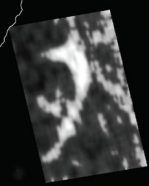Detecting an eerie sea glow
At night, glowing bacteria can give large areas of the sea a surreal milky color.
By Emily Sohn
Out at sea, there are nights when huge patches of the water’s surface glow with an eerie white light. Sailors have been telling tales of these “milky seas” for hundreds of years, but only now have scientists finally documented the phenomenon.
First, Steve Miller of the Naval Research Laboratory and his coworkers scoured ship records for mentions of glowing seas. They found a carefully recorded sighting that dated back to Jan. 25, 1995. It had occurred in the Indian Ocean off the coast of Somalia.
 |
|
A satellite image reveals the soft, white glow of a large patch of water in the Indian Ocean. The squiggly line (upper left corner) represents the coast of the African country Somalia.
|
| Steven D. Miller/Proceedings of the National Academy of Sciences |
The scientists then looked at satellite images taken of this area around that time. The images confirmed the event, and analyses showed that the glowing water covered 15,400 square kilometers (an area about the size of Connecticut). The glow appeared three nights in a row, and the patch moved with the currents.
The soft, white light, the researchers say, probably comes from an unusually large population of glowing bacteria called Vibrio harveyi, which live together with microscopic algae.
As satellite sensor technology improves, scientists hope to be able to detect glow patches as they happen. Then, investigators can race to the scene and learn more about what’s going on.
Going Deeper:
Brownlee, Christen. 2005. Milky seas clarified. Science News 168(Oct. 1):213. Available at http://www.sciencenews.org/articles/20051001/fob7.asp .
You can learn more about bioluminescent bacteria and animals at www.lifesci.ucsb.edu/~biolum/ (University of California, Santa Barbara).







